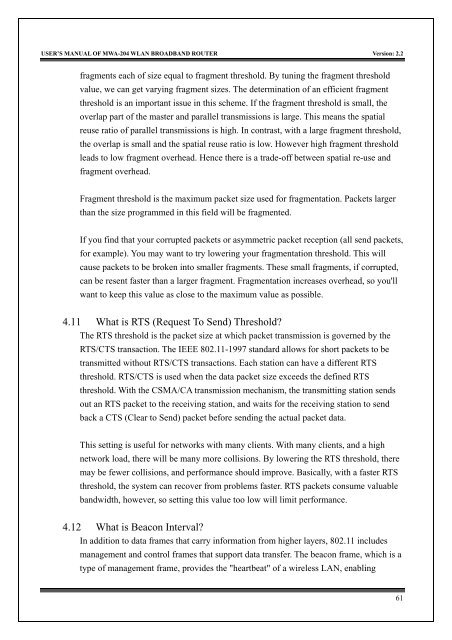MWA-204 User's Manual v2.0 - MyTek Communication
MWA-204 User's Manual v2.0 - MyTek Communication
MWA-204 User's Manual v2.0 - MyTek Communication
You also want an ePaper? Increase the reach of your titles
YUMPU automatically turns print PDFs into web optimized ePapers that Google loves.
USER’S MANUAL OF <strong>MWA</strong>-<strong>204</strong> WLAN BROADBAND ROUTER Version: 2.2fragments each of size equal to fragment threshold. By tuning the fragment thresholdvalue, we can get varying fragment sizes. The determination of an efficient fragmentthreshold is an important issue in this scheme. If the fragment threshold is small, theoverlap part of the master and parallel transmissions is large. This means the spatialreuse ratio of parallel transmissions is high. In contrast, with a large fragment threshold,the overlap is small and the spatial reuse ratio is low. However high fragment thresholdleads to low fragment overhead. Hence there is a trade-off between spatial re-use andfragment overhead.Fragment threshold is the maximum packet size used for fragmentation. Packets largerthan the size programmed in this field will be fragmented.If you find that your corrupted packets or asymmetric packet reception (all send packets,for example). You may want to try lowering your fragmentation threshold. This willcause packets to be broken into smaller fragments. These small fragments, if corrupted,can be resent faster than a larger fragment. Fragmentation increases overhead, so you'llwant to keep this value as close to the maximum value as possible.4.11 What is RTS (Request To Send) Threshold?The RTS threshold is the packet size at which packet transmission is governed by theRTS/CTS transaction. The IEEE 802.11-1997 standard allows for short packets to betransmitted without RTS/CTS transactions. Each station can have a different RTSthreshold. RTS/CTS is used when the data packet size exceeds the defined RTSthreshold. With the CSMA/CA transmission mechanism, the transmitting station sendsout an RTS packet to the receiving station, and waits for the receiving station to sendback a CTS (Clear to Send) packet before sending the actual packet data.This setting is useful for networks with many clients. With many clients, and a highnetwork load, there will be many more collisions. By lowering the RTS threshold, theremay be fewer collisions, and performance should improve. Basically, with a faster RTSthreshold, the system can recover from problems faster. RTS packets consume valuablebandwidth, however, so setting this value too low will limit performance.4.12 What is Beacon Interval?In addition to data frames that carry information from higher layers, 802.11 includesmanagement and control frames that support data transfer. The beacon frame, which is atype of management frame, provides the "heartbeat" of a wireless LAN, enabling61


